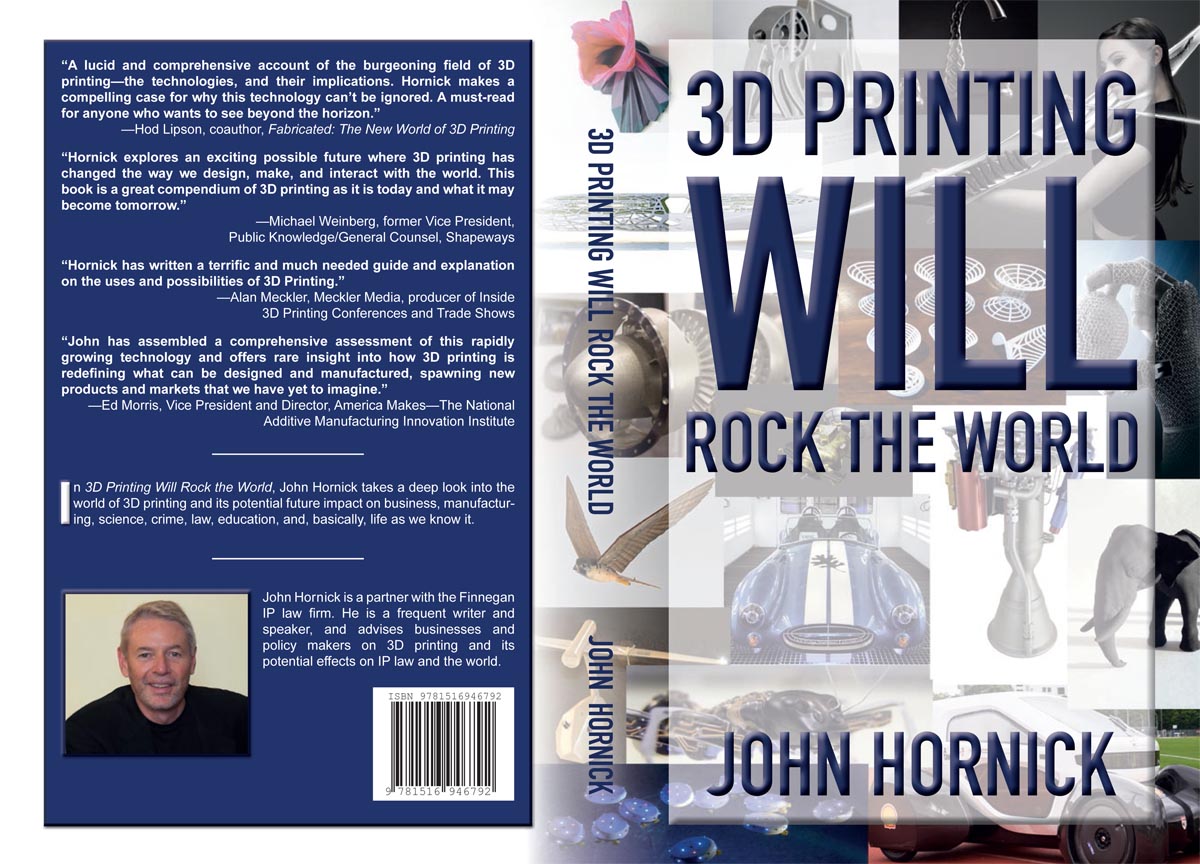Want to know how, in specific detail, 3D printing will rock the world? Well, then, IP lawyer and 3D printing expert John Hornick has the book for you! I had the pleasure of reading Hornick’s new book 3D Printing Will Rock the World (available on Amazon) and he does an excellent job of describing exactly how 3D printing will rock the world from a technological, economic, and, even, social standpoint. And, by the end of his book, readers may very well be convinced that, because of this technology, the world will be so thoroughly rocked that it will become unrecognizable.
As a 3D printing enthusiast, it was great to feel as though John was battling the naysayers who might see 3D printing as a fad that would surely evaporate after the most recent hype bubble burst. With lawyerly preparation for what potential detractors of 3D printing might say, he was prepared to defend the impact of the technology at every turn. Take, for instance, this reply to an argument regarding the widespread adoption of home 3D printers:
Talking heads who believe the cost of consumer-grade 3D printers (about $400 to $5,000) will deter their widespread adoption underestimate the human drive to make. There are about six million woodworkers in the United States, both professional and amateur. Amateur woodworking is a multibillion-dollar industry. About half a million table saws are sold every year, ranging in price from about $300 to well over $3,000, and a table saw is only one of many machines and tools needed to outfit a woodshop. There is no reason why people will not spend the same for a machine that can make whatever they want.
In discussing the ways that the technology will free us from the control of large, centralized manufacturers, Hornick paints a convincing future in which distributed manufacturing will be the norm. And where, even if mass production is still necessary, it will be disrupted to the point that it will these producers will no longer dominate the marketplace.
An old-line manufacturing company, Plates4-8, mass-produces millions of your plate design, using economies of scale. Plates4-8 will probably never switch its mass-production lines from traditional machines to 3D printers if the markets for its plates stay the same. But that is a big if because you will eventually own a 3D printer that can make many things, including dinner plates. Or you may have a shop down the street that can print your plate, or someone in your Friends Network may have a purpose-built dinnerware printer. Or an Internet 3D printing fabricator will offer to make your plate. If you have eight dinner plates and one breaks, you can print one to replace it. If you can print one plate, you can print eight (along with all of the other pieces that make up a set), and if you can print eight, you no longer need Plates4-8. Once you can do that, Plates4-8 may still have a market for plates, but it will probably be much smaller, and mass- producing plates may no longer be profitable. Plates4-8 may then change its production lines to 3D printers because it will be making far fewer plates and will probably be customizing them. In fact, every plate in a set may be a little different.
While regular readers of 3DPI may feel as though they already know how the technology is changing existing modes of production, Hornick does an excellent job of exploring every aspect of 3D printing to such a degree that both experts and laypeople will learn a great deal from the text. Discussing the new methods of design enabled by the technology, for example, he describes how 3D printing will not only improve existing products, but also lead to entirely new objects we never even imagined existing. These include robotic ant factories, human limbs with built-in sensors, and self-assembling objects.
Of course, he also handles the topics that I usually find to be the most boring, but that those outside of the industry (mom, dad, lady sitting next to me at the hair salon) find to be the most interesting and troubling, like 3D printed guns and bombs, as well as IP law. But John brings to these topics a frank realness and insight that even had me reading them. And when he describes the use of 3D printing to create replicas that will make us have a hard time distinguishing the real from the fake, I was definitely on board.
At the same time, the language he uses is clear and easy to understand. More than that, what could be a dry book outlining the game-changing nature of 3D printing is actually funny, as Hornick approaches the topic with a light touch. Like Star Trek references? Well, then you’ll love the role that ZeframWD plays in his book, as this warp drive manufacturer just cannot get a break! I guess they should have adopted 3D printing sooner.
In all, Hornick’s book is a thoughtful, funny, and thorough argument for, not only why 3D printing is here to stay, but why it will change everything. At the same time, through straightforward hypotheticals, he is able to portray what a world rocked by 3D printing will look like. Give it a read and you’ll see that future is, overall, a rockin’ one. You can find John’s book on Amazon here.




